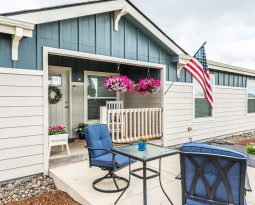Small Manufactured Homes Will ‘Check all the Boxes’ for Living Legally in a ‘Tiny Home’
In early 2019 we posted our blog addressing the legality issues plaguing “tiny” houses and the available “make sense” manufactured homes alternatives for tiny home aficionados.
Fast forward five years later. The so-called tiny home movement has gained momentum, but is plagued with the legalities of residing in a home without any universal building code requirements and/or financing options.
Living Legally In A “Tiny Home” Can Be Exceedingly Difficult, But Not Necessarily – What is a “tiny home”? Most of those television depictions seem to indicate that it is a structure built upon a wheeled trailer offering under 400 square feet of living space. However, there are those of the tiny home community that suggest the definition should include any small home under 800 to 1,000 square feet.
Many local governments have a minimum size requirement (often 800 to 1,000 square feet) for single family homes, prohibiting construction and/or installations of tiny homes on their own plots. Those minimum size requirements and the absence of a national certification by the builder, eliminates habitation, except perhaps as an auxiliary dwelling unit (granny flat, guest house),etc.
Park Model RV’s And Small Manufactured Homes: How Are They Different? – Today’s modern manufactured homes are the only form of residential housing built to a federally mandated national building code: The Manufactured Home Construction and Standards Act of 1974 (HUD Code). HUD Code applies only to homes with a minimum 400 square feet of living space.
Major recognized manufactured home builders also build under 400 sq. ft. Park Model RV’s that should be included in the “tiny home” conversation. These homes are generally constructed to a national recreation vehicle code that certifies builder’s stringent adherence to health, safety and roadworthy requirements.
Park models produced by manufactured home builders are skillfully designed to maximize comfortable living space and incorporate the same quality of building materials, appliances, amenities and workmanship utilized in construction of the larger HUD Code manufactured homes and site-built homes.
Quality constructed Park Models are welcome in recreational park communities, campgrounds and are ideal for guest homes, accessory dwelling units, vacation homes, second homes, etc. However, there are no known under 400 square square feet homes or recreational vehicles that will meet requirements as continuing permanent housing.
The only form of small living homes that check all the boxes for living legally full time, comfortably, inexpensively, with financing options, are HUD Code manufactured homes with over 400 square feet of living space.







